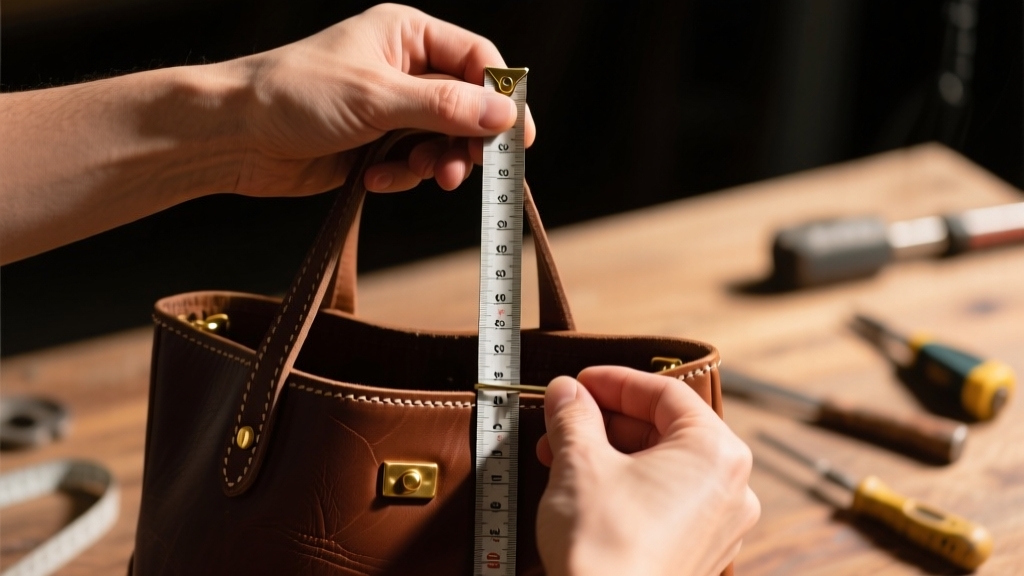
To measure a bag, use a flexible tape and start with height from base to top opening, excluding handles unless specified. Measure width across the widest part, including gussets or pleats, then check depth from front to back.
For luggage, include wheels and handles and sum all dimensions to meet airline rules. Backpack volume needs length, width, and height, or a special formula for rounded shapes. Keep these detailed steps in mind to guarantee you get the exact size you need and discover how to refine your approach further.
Key Takeaways
- Lay the bag flat and empty to maintain its natural shape before measuring.
- Use a flexible measuring tape to accurately measure height, width, and depth.
- Measure height from the base to the top opening, excluding handles unless specified.
- Measure width at the widest part, including gussets or pleats if present.
- For straps or handles, measure the drop length from the top opening to the highest point.
Measuring Poly Bags Accurately
When measuring poly bags accurately, you need to start by determining the correct dimensions to guarantee a proper fit for your product.
Begin with the width, which is usually the inside diameter or flat width when the bag lies flat. For cylindrical containers, calculate width as half the drum’s circumference plus 2 inches for material allowance.
Length combines container height, diameter, and an extra 4 inches for folding or tying. It is also important to consider security measures in packaging to ensure product safety during handling and transit.
For box liners, width equals half the box’s circumference plus 2 inches, and length adds half the narrow width, box height, and 5 to 8 inches for folds. Always measure your product’s length, width, and depth precisely to select a bag that comfortably accommodates it without excess or tightness.
This ensures protection and usability. Additionally, understanding the nominal thickness and adhering to industry standards like those from NIST can help ensure your chosen bag meets quality and compliance requirements.
Steps to Measure Luggage for Airline Compliance
Although airline luggage policies may vary, knowing how to measure your bags accurately guarantees you avoid extra fees or delays.
Start by using a flexible tape measure to capture your luggage’s length, width, and height. Measure length from the bottom to the top, width at the widest point, and height while the bag stands upright. Be sure to include wheels and handles in your measurements since they add to the overall size.
Add these three dimensions to confirm your bag doesn’t exceed the typical 62-inch limit for checked luggage. Don’t forget to include handles and wheels in your measurements, especially for carry-ons, as airlines count these.
Always check your specific airline’s size limits before packing. Since airlines have specific maximum dimensions, measuring carefully ensures your luggage meets size requirements, preventing last-minute repacking or fees at the airport.
Proper Technique for Measuring Tote Bags
Since tote bags come in various shapes and structures, you’ll need to use specific techniques to measure their dimensions accurately.
Start by laying the bag flat on a table and verify it’s empty to maintain its natural shape. Use a flexible measuring tape for precision, especially with curved or gusseted designs. Proper handling and preventive measures help maintain the bag’s shape and avoid damage during measurement.
Follow these steps for proper measurement:
- Measure height from the bottom edge to the top of the main body, excluding handles.
- Measure width across the widest part, including gussets or pleats.
- Measure depth from front to back at the widest point, usually the bottom or gusset.
- For gusseted totes, stand the bag upright and measure height, width, and gusset depth separately.
It’s important to record the key measurements such as height, width, depth, and handle length to ensure the bag meets specific needs and usability. This method ensures you capture accurate dimensions for any tote bag style.
How to Calculate Backpack Volume?
Calculating your backpack’s volume accurately requires choosing a measurement method that matches its shape and your intended use. For boxy backpacks, multiply length × width × height, but expect some overestimation. Regular maintenance also helps keep the luggage wheels in good condition for travel.
If your pack has a rounded, elliptical base, use the elliptic cylinder formula: π × a × b × height for better accuracy. For the most precise reading, try the fill method—fill every compartment with pellets or rice, then transfer to a graduated container to measure total volume.
Always measure with your backpack zipped and fully packed to reflect real use. Since manufacturer data varies, independently measuring your backpack’s volume ensures a fair comparison among different models.
Measuring Handbags and Purses Correctly
When measuring handbags and purses correctly, you need to focus on four core dimensions: height, width (or length), depth, and the drop of the handle or strap. Use a flexible tape measure and place the bag upright on a flat surface for accuracy. Follow these steps:
- Measure height from the base to the top opening.
- Measure width as the longest horizontal distance across the base or front.
- Measure depth from the back to the front, usually at the base or middle.
- Measure strap drop from the top opening to the highest natural point of the handle or strap. For curved handbags, it is important to measure from the longest points to capture the correct dimensions curved handbags.
Consistently applying these methods guarantees precise sizing, helps assess capacity, and avoids surprises when selecting or storing your handbag. Additionally, considering the strap adjustment is key for comfort and to complement your style when carrying the bag.
Frequently Asked Questions
How Do I Measure a Bag With Irregular or Asymmetrical Shapes?
You measure an irregular bag by laying it flat on a stable surface and smoothing out any creases. Use a flexible tape to follow curves and bulges accurately. Measure the longest, widest, and highest points, including handles or wheels.
Take multiple measurements for consistency, mark key points like seams, and record both metric and imperial units. Always double-check and round up to guarantee precision, especially for custom or packed bags.
What Tools Work Best for Measuring Soft or Flexible Bags?
You’ll want to use a flexible measuring tape for soft or flexible bags since it easily conforms to curves and corners. Avoid rigid rulers; they won’t capture the shape accurately. If you need precision for small parts, calipers work well, but they’re less practical for overall size.
Measurement apps can help estimate dimensions using photos, while digital measuring software provides precise data if you know the bag’s details. Multiple measurements ensure accuracy.
How to Measure a Bag’s Internal Compartments Separately?
To measure each internal compartment separately, first empty the bag and lay it flat. Use a flexible measuring tape to get the length, height, and depth inside each compartment, measuring from wall to wall.
Note any dividers or pockets and measure those individually. Record each dimension carefully. For irregular shapes, measure the longest points. This gives you accurate, usable space for each compartment, so you can assess capacity or fit precisely.
Should I Include External Attachments When Measuring Bag Size?
Yes, you should always include external attachments like wheels, handles, and side pockets when measuring your bag’s size. Airlines and shippers consider these parts in total dimensions, so ignoring them often leads to non-compliance, fees, or repacking.
Make sure handles are fully retracted and measure height, width, and depth with all protrusions. This way, you’ll accurately assess your bag’s size and avoid surprises at check-in or shipping.
How Do Humidity or Temperature Affect Bag Measurement Accuracy?
You know what they say: “A watched pot never boils,” and similarly, uncontrolled humidity and temperature can skew your bag measurements. Moisture causes materials to swell or shrink, altering weight and volume readings.
Electronics inside your measuring tools can short or misread due to condensation or thermal expansion. To keep accuracy sharp, control environment conditions, recalibrate instruments often, and use desiccants or climate chambers to stabilize measurements reliably.
Avoid Size Surprises: Right Way to Measure Bags and Luggage
Now that you know how to measure bags precisely, you’re perfectly prepared to pick the proper size for any purpose. Whether it’s poly bags, luggage, tote bags, backpacks, or handbags, practicing proper positioning and precise measuring prevents packing problems.
Keep your measurements consistent and careful to confidently comply with airline rules or organize your belongings efficiently. Measuring methodically makes managing your materials much more manageable and maximizes your packing potential every time.
